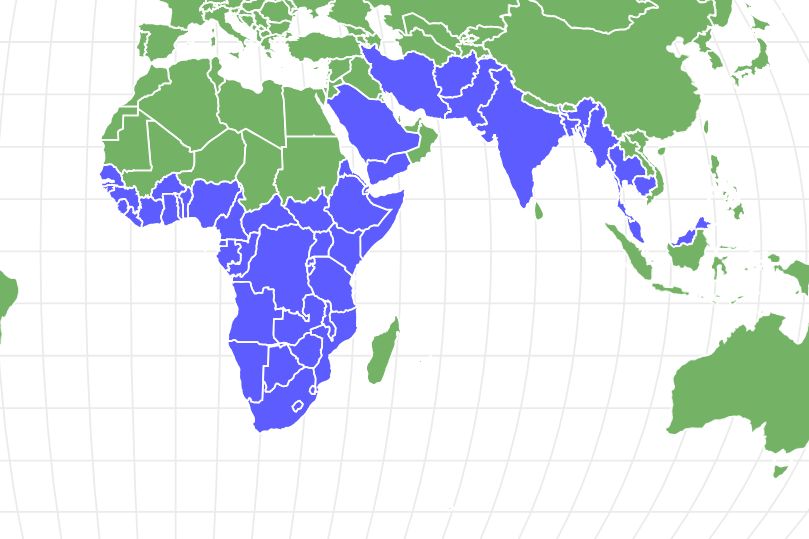Leopard
Panthera pardus
Spends much of the time high in the trees!
Advertisement
Leopard Scientific Classification
- Kingdom
- Animalia
- Phylum
- Chordata
- Class
- Mammalia
- Order
- Carnivora
- Family
- Felidae
- Genus
- Panthera
- Scientific Name
- Panthera pardus
Read our Complete Guide to Classification of Animals.
Leopard Conservation Status
Leopard Facts
- Prey
- Deer, Warthog, Rodents
- Name Of Young
- Cub
- Group Behavior
- Solitary
- Fun Fact
- Spends much of the time high in the trees!
- Estimated Population Size
- Stable
- Biggest Threat
- Trophy hunting and habitat loss
- Most Distinctive Feature
- Dense patterned fur and long, sharp teeth
- Other Name(s)
- Panther
- Gestation Period
- 90 - 105 days
- Habitat
- Rainforest, grassland and mountainous regions
- Diet
- Carnivore
- Average Litter Size
- 3
- Lifestyle
- Nocturnal
- Common Name
- Leopard
- Number Of Species
- 7
- Location
- Sub-Saharan Africa and southern Asia
- Slogan
- Spends much of the time high in the trees!
- Group
- Mammal
Leopard Physical Characteristics
- Color
- Yellow
- Black
- Dark Brown
- Golden
- Skin Type
- Fur
- Top Speed
- 36 mph
- Lifespan
- 10 - 15 years
- Weight
- 30kg - 90kg (66lbs - 198lbs)
- Length
- 100cm - 190cm (40in - 75in)
- Age of Sexual Maturity
- 2 - 2.5 years
- Age of Weaning
- 3 months
View all of the Leopard images!
The leopard is a medium-sized wildcat that lives in a variety of different habitats across sub-Saharan Africa and southern Asia. Distinguished by their uniquely beautiful “spotted” coat, leopards are apex predators that ambush prey from a perch in the trees. This hunting method is unlike their big cat cousins who engage their prey in high-speed chases.

Anatomy and Appearance
The leopard is an animal with a long, lithe body — which powerful legs support — and a long tail that they use for balance in the trees. Leopards can vary greatly in their coloration and markings depending on their surrounding habitat. Those on open grasslands have a light yellow, sun-bleached background coat. Meanwhile, those that live in forests tend to be darker to blend into the shade and have more markings for camouflage.
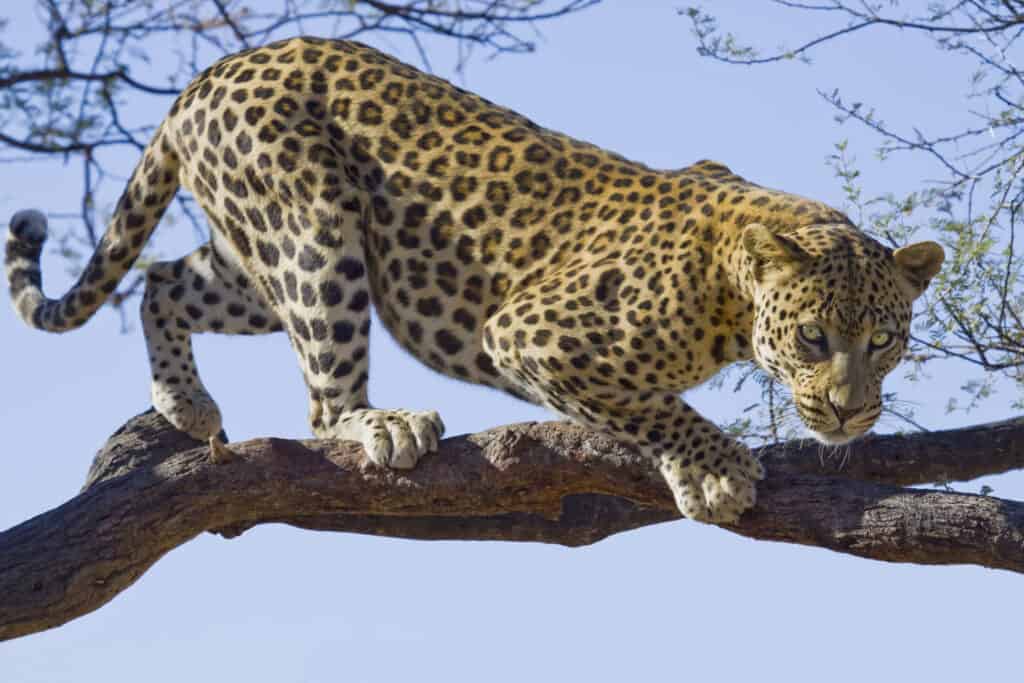
Leopards are incredibly strong and muscular animals and are able to pull themselves up trees using their legs and retractable claws.
©iStock.com/lightstock
The dark, ring-like patterns that cover the leopard’s coat are rosettes, which provide them with camouflage in their surrounding environment. Leopards are incredibly strong and muscular animals and are able to pull themselves up trees using their legs and retractable claws. Like many other feline species, the leopard is able to draw its claws into folds of skin on its paws. That ability ensures that their claws don’t become blunt while the animal is walking about. Their remarkable eyesight and hearing give them a great advantage during night hunting.
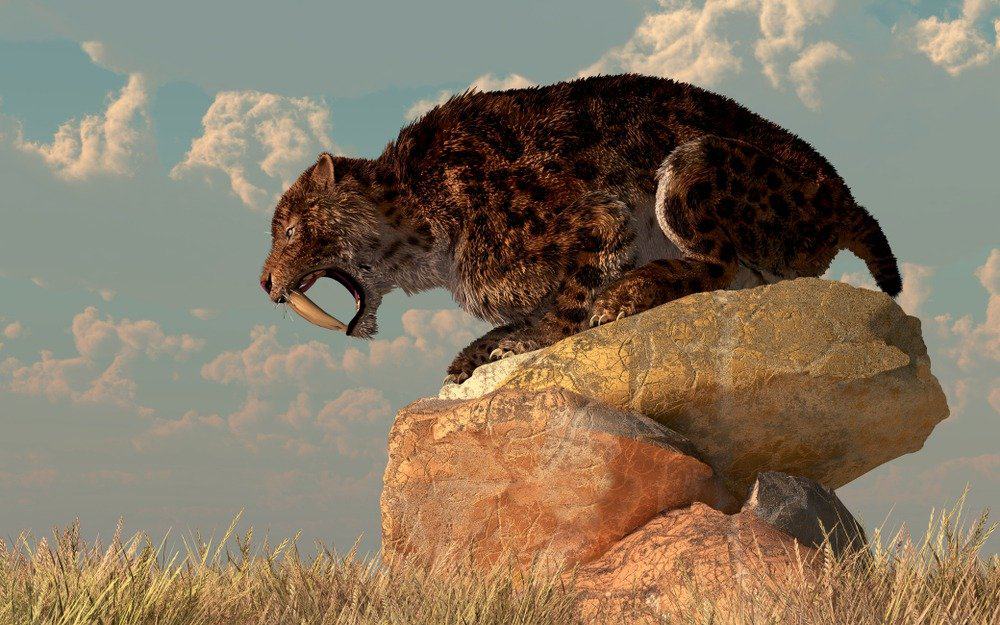
The Saber-toothed
tiger
was an ancestor of all big cats – including the leopard.
©Daniel Eskridge/Shutterstock.com
Evolution
The first mammals are believed to have lived 208 million years ago — after the extinction of dinosaurs. The first carnivores came from animals known as miacoids about 60 million years ago. These tree dwellers were about the size of a domestic cat and had developed sharp crushing teeth. Miacoids are the oldest relative to the modern-day leopard.
Carnivores, or the Carnivora order, split into two sub-orders — Caniformia and Feliformia — around 40 million years ago. The Caniformia group was more bear-like and evolved into bears, dogs, weasels, raccoons, skunks, badgers, sea lions, walruses, and seals. Feliformia was more cat-like and evolved into cats, hyenas, and mongooses.
Proailurus, the genus of the oldest cat, lived 30 million years ago, the first fossils of which researchers discovered in France in 1879. This arboreal creature weighed around 25 pounds and had eight more teeth than modern cats. 20 million years ago, the direct ancestor of modern cats, Pseudaelurines, lived, according to the fossil record. Fossil records from the La Brea Tar Pits indicate that the saber-tooth tiger, Smilodon, lived in that area at least 2.6 million years ago. These big cats became extinct around 10,000 years ago.
Sub-Species
There are seven different subspecies of leopards. Each differs in appearance and geographic location, with the African leopard being the most common and widespread.
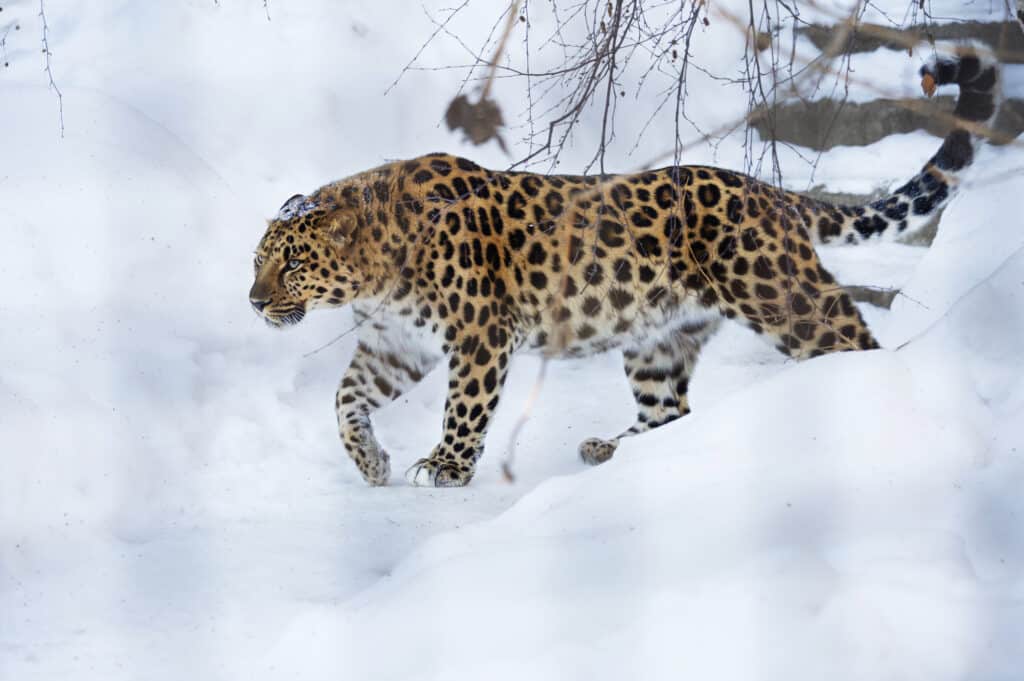
The Amur leopard is a unique sub-species that is under threat of extinction.
©iStock.com/opposable-toothed mandibles
- African leopards, Panthera pardus pardus, reside in a variety of African habitats, including deserts, forests, mountains, and coastlines. They are fast and agile, and they are able to carry heavy prey up trees with ease.
- Amur Leopard, Panthera pardus orientalis, is native to southeastern Russia and northern China. This critically endangered animal is one of the rarest cats on earth.
- Anatolian Leopard, Panthera pardus tulliana, is native to Iran, Turkey, the Caucasus, Azerbaijan, Georgia, Armenia, Iraq, Iran, Afghanistan, and Pakistan. The last official sighting of the Anatolian leopard occurred in 1974 after the animal was killed following an attack on a woman. Some scientists have declared it extinct while others believe there are still 10-15 Anatolian leopards in the wild.
- Barbary Leopard, Panthera pardus panthera, sometimes called the North African leopard, lives in the Atlas Mountains of North Africa. Experts thought them to be extinct, but nonetheless, a small population survives.
- Sinai Leopard, Panthera pardus jarvisi, is a critically endangered big cat native to the Arabian Peninsula. It lives in mountainous uplands and steppes.
- South Arabian Leopard, Panthera pardus nimir, is also native to the Arabian Peninsula and is also critically endangered. It is the smallest member of the leopard family and adapted to life in the desert.
- Zanzibar Leopard, Panthera pardus pardus, was a large African leopard who last lived on Unguja Island in Zanzibar, Tanzania. Declared extinct in the mid-1990s, the Zanzibar leopard was the island’s largest carnivore and an apex predator.

The Javan leopard dwells on Java Island, Indonesia.
©ylq/Shutterstock.com
Habitat
Leopards have not only the widest range of all big cats, but they are also one of the most adaptable. In fact, they live in a variety of different habitats. They commonly call home areas throughout sub-Saharan Africa and southern Asia. There are also small and isolated populations of leopards inhabiting remote geographic locations in the Far East, Northern Africa, and Arabia. Provided there is a good source of cover and an ample supply of food, leopards will inhabit numerous habitats. Those include tropical rainforests, tree-lined savannas, barren deserts, and mountain highlands.
One of the reasons why experts believe they continue to survive successfully throughout much of their natural range is that leopards have adapted to the growing presence of people. In fact, they both live and hunt in areas close to urban activity. However, in some parts of their natural range, deforestation and growing settlements threaten populations with the loss of their habitat.

Leopards spend much of their time in trees, often waiting to jump down on unsuspecting prey.
©Pavith Malaka/Shutterstock.com
Behavior and Lifestyle
Leopards are solitary animals that hunt both on the ground and in the trees. They are excellent climbers, spending the majority of daytime hours resting in tree branches or under sheltered rocks. They are unique amongst large felines, as leopards rely heavily on being able to get close enough to their prey before ambushing it, rather than expelling vast amounts of energy in a high-speed chase. Once they catch and kill their prey, they drag it to safety either into dense vegetation or up a tree trunk and into the branches.
Leopards are solitary animals that mark their territory using scent markings and by producing rough, rasping calls, which some say sound like sawing through coarse wood. Home range sizes vary depending on the habitat and the food available but those of male leopards are significantly larger than those of their female counterparts, which often overlap the ranges of a number of both males and other females (sometimes by up to 40%).
Check out some incredible facts about leopards.
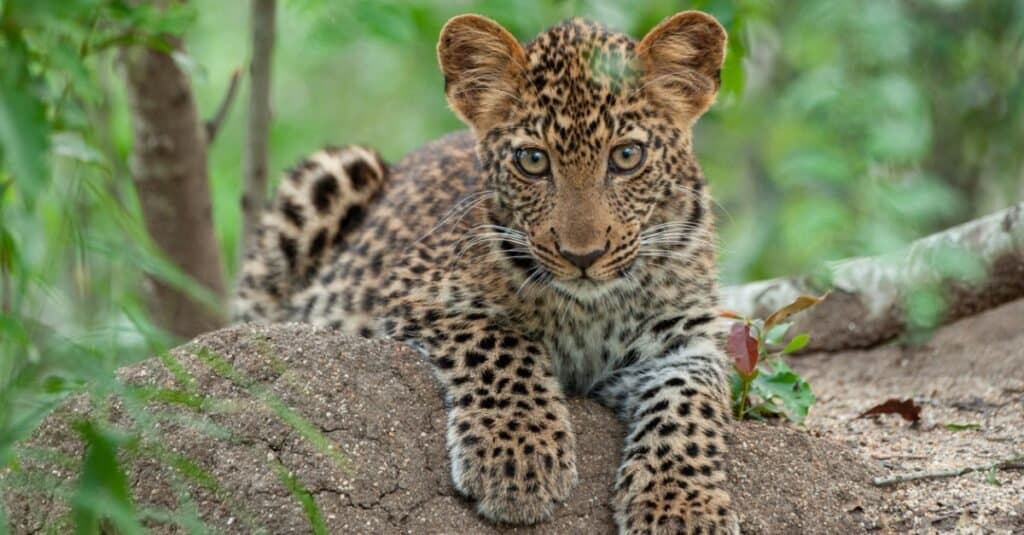
Baby leopards subsist on mother’s milk for the first three months of life
©iStock.com/RudiHulshof
Reproduction and Life Cycles
Throughout their natural range, leopards have no distinctive breeding season, with females instead being able to reproduce every couple of months. After a gestation period that lasts for around three months, the female leopard gives birth to between two and six cubs that are born blind and weigh about one pound. Leopard cubs are incredibly vulnerable in the wild. Because of that, they remain hidden in dense vegetation, into which their dark, woolly fur and blurry spots allow them to camouflage. They hide this way until they are able to follow their mother around at between 6 and 8 weeks of age.
Weaned at around 3 months old, leopard cubs will remain with their mother for another 18 months until she is ready to mate again and encourages their young to independently establish their own territories. Although male leopards live solitary lives except when mating, female leopards’ range tends to overlap their mothers. Leopards tend to live for between ten and fifteen years in the wild, depending on the habitat and the food supply available.
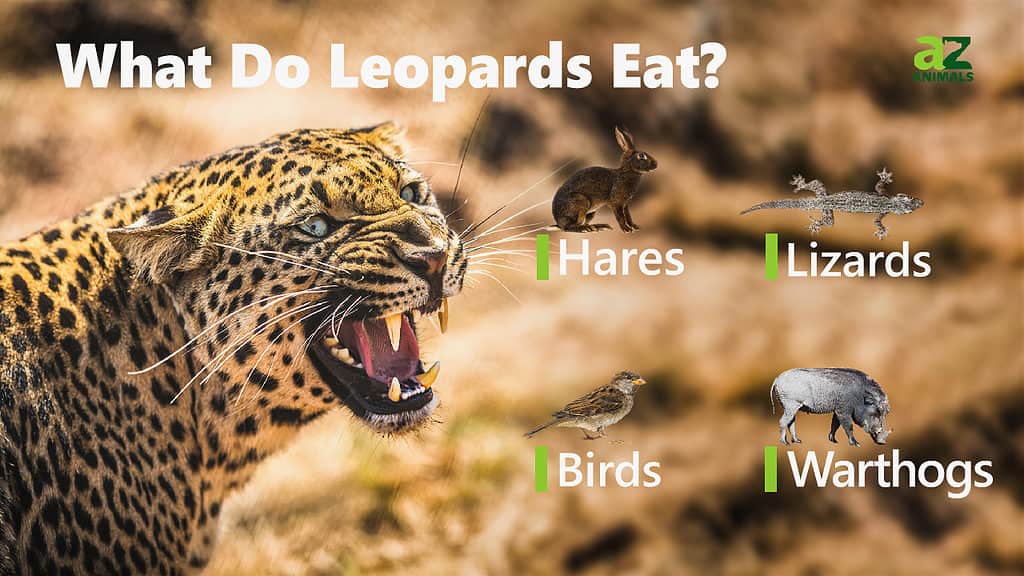
Diet and Prey
Leopards primarily hunt medium-sized mammals such as deer and warthogs, and these cats often ambush this prey from the branches above or dense vegetation just meters away. The leopard also eats a wide variety of small prey, including birds, reptiles, and rodents. They even hunt dung beetles when larger animals are scarce.
By eating much smaller (and a wider variety) of prey, leopards are able to avoid intense competition for food from other large carnivores like tigers and hyenas, with which they share parts of their natural range. Leopards are incredibly strong and capable of taking prey much heavier than themselves. Such prey included antelopes. They then remarkably haul their meal into the safety of the branches to either eat it immediately or cache it for later.
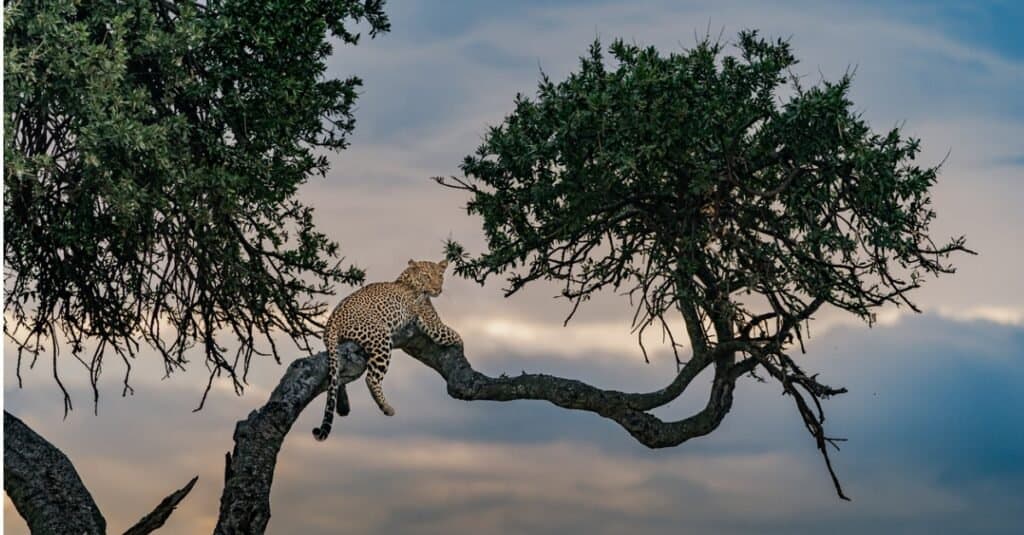
Because their uniquely skilled hunting methods place them at the top of the food chain, the biggest threat to leopards is other leopards.
©iStock.com/Hermis Haridas
Predators and Threats
Due to the fact that the leopard is a stealthy and apex predator throughout its natural environment, generally, the biggest threat to adult leopards are other leopards, along with the occasional lion or tiger that can get close enough.
Nile crocodiles also pose a threat due to their immense strength, extreme aggression, and willingness to sink their fangs into anything. They have taken on leopards crossing bodies of water and won.
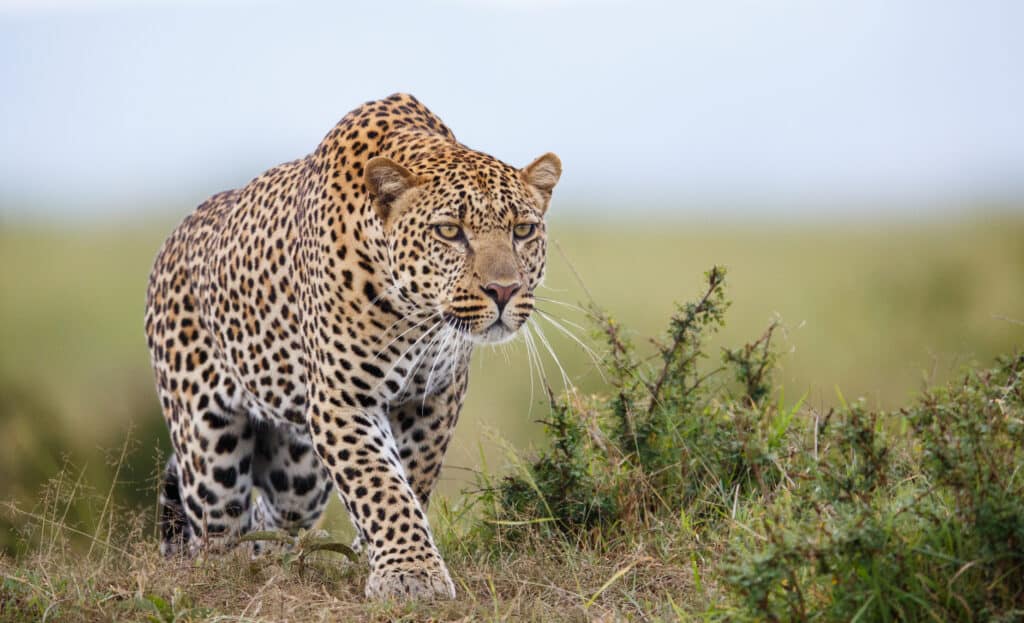
Leopards tend to live between ten and fifteen years in the wild, depending on the habitat and the food supply available.
©iStock.com/UrmasPhotoCom
Pythons are another especially formidable foe and have in the past overpowered these beautiful apex predators.
Young leopard cubs however are much more vulnerable and the fact that they have numerous natural predators leads them to remain hidden in dense vegetation for their first couple of months. Although, it is during the times when their mother is off hunting that leopard cubs are most at threat from hyenas, jackals, lions, tigers, snakes, and birds of prey. Despite their adaptability to differing surroundings, leopard populations in parts of their natural range are declining due to habitat loss to the timber industry and agriculture and hunting by humans as trophies and for their meat and fur.
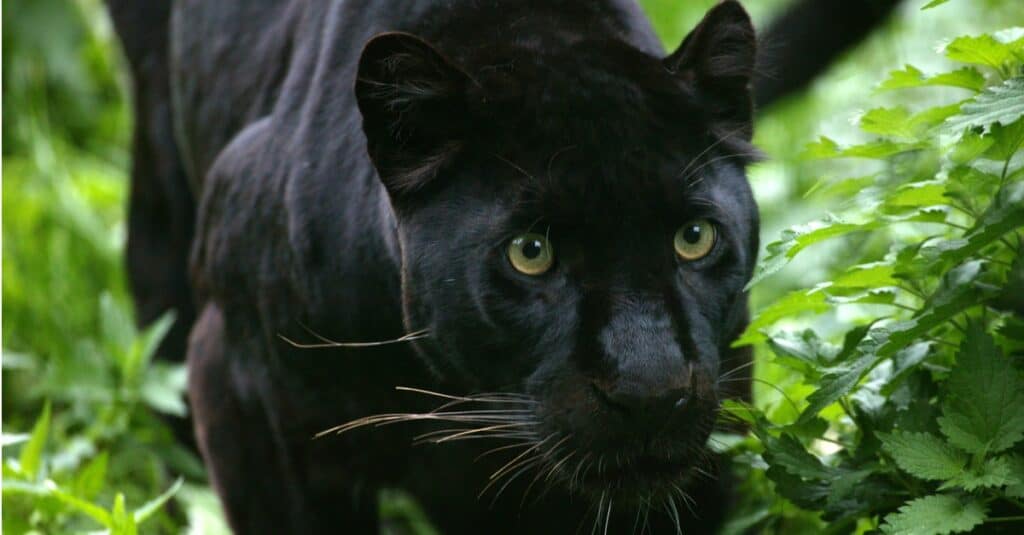
The black panther is a leopard that has a completely black coat of fur, with occasional faint markings.
©iStock.com/slowmotiongli
Interesting Facts and Features
Originally thought to be a hybrid of the lion and the jaguar, the leopard has been the subject of much genetic confusion and wasn’t really distinguished properly until just over 100 years ago. Some of the confusion is thought to come from the black panther, which is a leopard that has a completely black coat of fur, with occasional faint markings.
This genetic mutation, melanism, causes large amounts of dark pigment to occur in the skin and fur, and a number of mammalian species exhibit it. Black panthers tend to occur most in dense forests with larger populations being found in southern Asia than in Africa and are born into a litter that also contains yellow cubs. Black panthers are actually fairly common and amazingly enough, researchers believe that up to 50% of the leopards found inhabiting the thick, tropical rainforests of the Malay Peninsula are black.
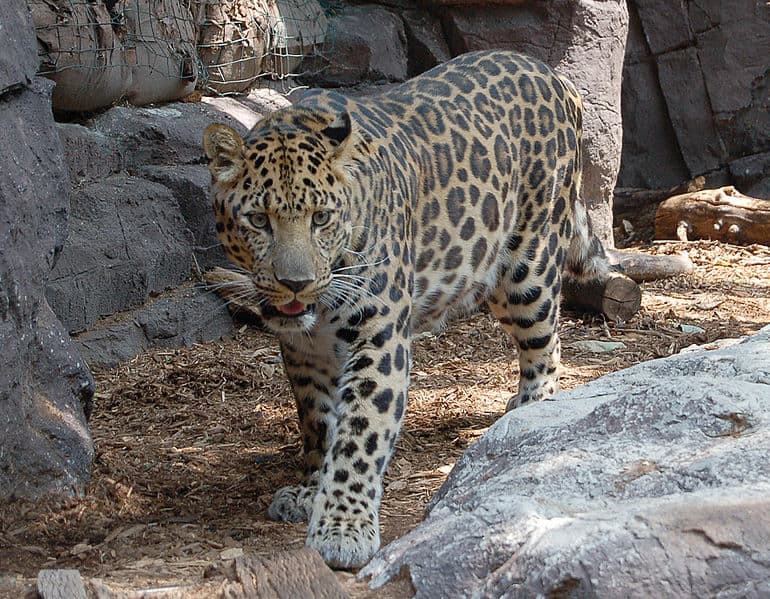
Amur Leopard at Philadelphia Zoo
©Derek Ramsey (Ram-Man), CC BY-SA 2.5, via Wikimedia Commons – License
Relationship with Humans
Since big game hunting took off in Africa, the leopard has been one of the most sought-after animals for hunters to kill. Because leopards are part of the African “Big Five” — the most desirable animals for sports hunters — trophy hunting has severely affected them in some areas. Locals who live near these big cats also often kill them for their meat and fur. Beyond that, many see them as pests to farms and livestock, due to their lack of fear of people, even though people seldom see them.
Despite their persecution, recent booms in the tourist industry in Africa have meant that more and more people are paying for the privilege to see one of these majestic animals in the wild. That brings money into local communities. Because of that, locals are now more willing to protect these cats, as leopards are providing an important and new-found source of good income for them.
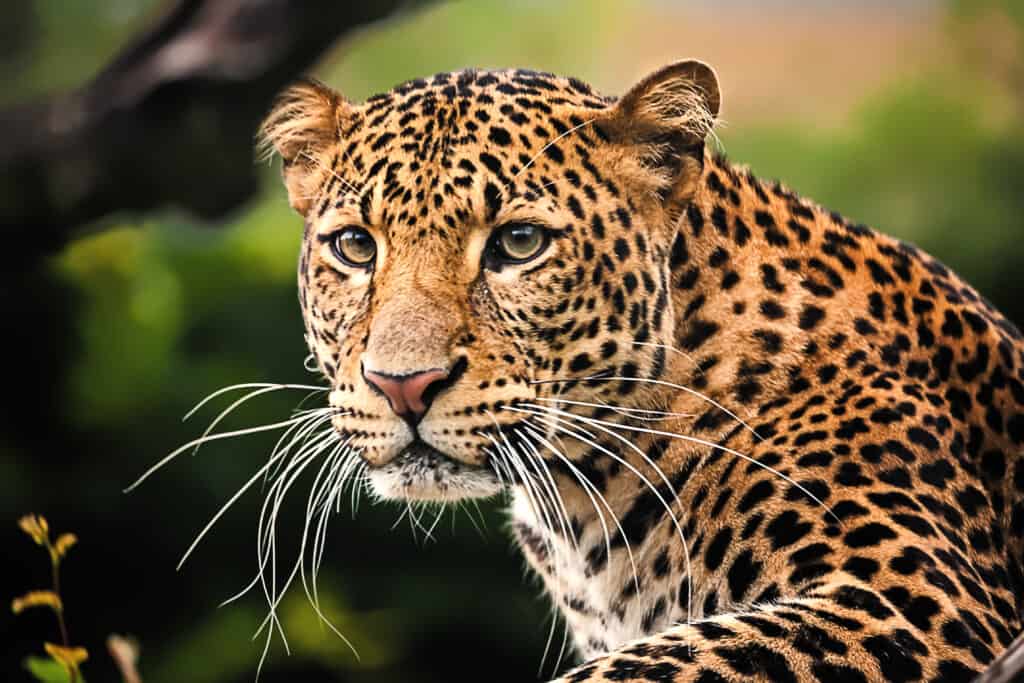
The Javan leopard is one of the most endangered animals in the world.
©abxyz/Shutterstock.com
Conservation Status and Life Today
Today, the IUCN lists the leopard as being Not Extinct in its natural environment, as populations are stable throughout much of its range. A number of sub-species, however, are either Endangered or Critically Endangered in their native habitats and one is thought to now be extinct. This is due to the fact that these populations are either small or geographically isolated, and because local hunting and habitat loss severely affect them. For example, the Javan leopard from the Indonesian island of Java is one of the most endangered animals in the world. In a number of African countries, however, sport hunters still legally hunt leopards as trophies, with annual quotas allocated by CITES (The Convention on International Trade in Endangered Species).
View all 98 animals that start with LLeopard FAQs (Frequently Asked Questions)
Are Leopards herbivores, carnivores, or omnivores?
Leopards are Carnivores, meaning they eat other animals.
What Kingdom do Leopards belong to?
Leopards belong to the Kingdom Animalia.
What phylum do Leopards belong to?
Leopards belong to the phylum Chordata.
What class do Leopards belong to?
Leopards belong to the class Mammalia.
What family do Leopards belong to?
Leopards belong to the family Felidae.
What order do Leopards belong to?
Leopards belong to the order Carnivora.
What genus do Leopards belong to?
Leopards belong to the genus Panthera.
What type of covering do Leopards have?
Leopards are covered in Fur.
Where do Leopards live?
Leopards live in sub-Saharan Africa and southern Asia.
In what type of habitat do Leopards live?
Leopards live in rainforests, grasslands, and mountainous regions.
What are some predators of Leopards?
Predators of Leopards include tigers, lions, and humans.
How many babies do Leopards have?
The average number of babies a Leopard has is 3.
What is an interesting fact about Leopards?
Leopards spend much of their time high in the trees!
What is the scientific name for the Leopard?
The scientific name for the Leopard is Panthera pardus.
What is the lifespan of a Leopard?
Leopards can live for 10 to 15 years.
What is a baby Leopard called?
A baby Leopard is called a cub.
How many species of Leopard are there?
There are 7 species of Leopard.
What is the biggest threat to the Leopard?
The biggest threats to the Leopard are trophy hunting and habitat loss.
What is another name for the Leopard?
The Leopard is also called the panther.
How fast is a Leopard?
A Leopard can travel at speeds of up to 30 miles per hour.
Who will win a fight between a leopard and a panther?
The biggest differences between a leopard and a panther are their size, color, and power. Panthers are larger than leopards since we are using the biologyof a jaguar to populate their physical statistics. Panthers can weigh upwards of 300lbs, but leopards max out at 198lbs. That disparity is significant and impactful in the fight.
Who Would Win in a Fight Between a Leopard and a Lion?
A lion would win a fight against a leopard because it is stronger, has better defenses, and regularly deals with prey larger than the leopard.
Who Would Win in a Fight Between a Leopard and a Gorilla?
A leopard would win a fight against a gorilla. It is too fast and vicious for a strong gorilla to fight off.
Who Would Win in a Fight Between a Leopard and a Hyena?
A leopard would win a fight against a hyena. The big cat is too skilled and deadly for the hyena to beat in a fight. Hyenas are used to fighting with backup in the form of their pack mates. However, they would come into this fight alone, putting them at an instant disadvantage.
Meanwhile, leopards live, hunt, and fight alone. Moreover, they take down big prey all by themselves. If the leopard was allowed to ambush the hyena, the fight would be over in seconds with the leopard’s mouth around its enemy’s neck.
Who would win the fight between a leopard and a tiger?
In the battle of leopard vs tiger, the tiger would win. Tigers often prey on leopards to take their kill or in defense of their territory.
How to say Leopard in ...
Thank you for reading! Have some feedback for us? Contact the AZ Animals editorial team.
Sources
- David Burnie, Dorling Kindersley (2011) Animal, The Definitive Visual Guide To The World's Wildlife
- Tom Jackson, Lorenz Books (2007) The World Encyclopedia Of Animals
- David Burnie, Kingfisher (2011) The Kingfisher Animal Encyclopedia
- Richard Mackay, University of California Press (2009) The Atlas Of Endangered Species
- David Burnie, Dorling Kindersley (2008) Illustrated Encyclopedia Of Animals
- Dorling Kindersley (2006) Dorling Kindersley Encyclopedia Of Animals
- David W. Macdonald, Oxford University Press (2010) The Encyclopedia Of Mammals
- About Leopards, Available here: http://www.awf.org/content/wildlife/detail/leopard
- Leopard Information, Available here: http://www.iucnredlist.org/apps/redlist/details/15954/0

